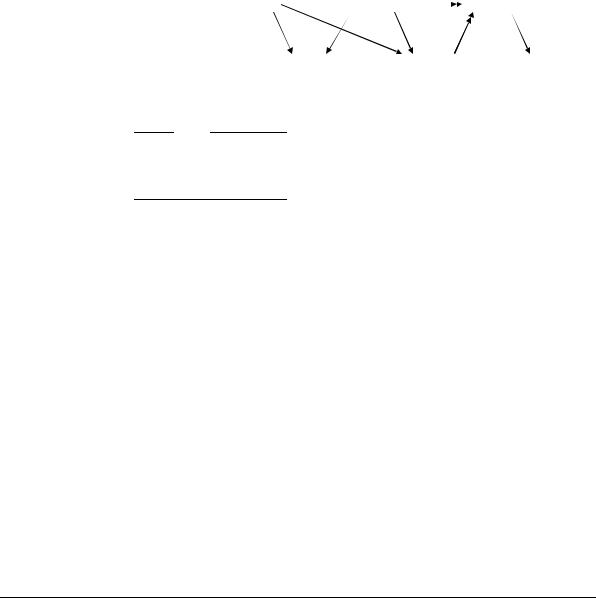
- •AMBA
- •Contents
- •List of Tables
- •List of Figures
- •Preface
- •About this document
- •Intended audience
- •Using this specification
- •Conventions
- •Typographical
- •Timing diagrams
- •Signals
- •Further reading
- •ARM publications
- •Feedback
- •Feedback on this product
- •Feedback on this specification
- •Introduction
- •1.1 About the AXI protocol
- •1.2 Architecture
- •1.2.1 Channel definition
- •Read and write address channels
- •Read data channel
- •Write data channel
- •Write response channel
- •1.2.2 Interface and interconnect
- •1.2.3 Register slices
- •1.3 Basic transactions
- •1.3.1 Read burst example
- •1.3.2 Overlapping read burst example
- •1.3.3 Write burst example
- •1.3.4 Transaction ordering
- •1.4 Additional features
- •Signal Descriptions
- •2.1 Global signals
- •2.2 Write address channel signals
- •2.3 Write data channel signals
- •2.4 Write response channel signals
- •2.5 Read address channel signals
- •2.6 Read data channel signals
- •Channel Handshake
- •3.1 Handshake process
- •3.1.1 Write address channel
- •3.1.2 Write data channel
- •3.1.3 Write response channel
- •3.1.4 Read address channel
- •3.1.5 Read data channel
- •3.2 Relationships between the channels
- •3.3 Dependencies between channel handshake signals
- •Addressing Options
- •4.1 About addressing options
- •4.2 Burst length
- •4.3 Burst size
- •4.4 Burst type
- •4.4.1 Fixed burst
- •4.4.2 Incrementing burst
- •4.4.3 Wrapping burst
- •4.5 Burst address
- •Additional Control Information
- •5.1 Cache support
- •5.2 Protection unit support
- •Atomic Accesses
- •6.1 About atomic accesses
- •6.2 Exclusive access
- •6.2.1 Exclusive access process
- •6.2.2 Exclusive access from the perspective of the master
- •6.2.3 Exclusive access from the perspective of the slave
- •6.2.4 Exclusive access restrictions
- •6.2.5 Slaves that do not support exclusive access
- •6.3 Locked access
- •Response Signaling
- •7.1 About response signaling
- •7.2 Response types
- •7.2.1 Normal access success
- •7.2.2 Exclusive access
- •7.2.3 Slave error
- •7.2.4 Decode error
- •Ordering Model
- •8.1 About the ordering model
- •8.2 Transfer ID fields
- •8.3 Read ordering
- •8.4 Normal write ordering
- •8.5 Write data interleaving
- •8.6 Read and write interaction
- •8.7 Interconnect use of ID fields
- •8.8 Recommended width of ID fields
- •Data Buses
- •9.1 About the data buses
- •9.2 Write strobes
- •9.3 Narrow transfers
- •9.4 Byte invariance
- •Unaligned Transfers
- •10.1 About unaligned transfers
- •10.2 Examples
- •Clock and Reset
- •11.1 Clock and reset requirements
- •11.1.1 Clock
- •11.1.2 Reset
- •Low-power Interface
- •12.2.4 Clock control sequence summary
- •Index

Channel Handshake
3.2Relationships between the channels
The relationship between the address, read, write, and write response channels is flexible.
For example, the write data can appear at an interface before the write address that relates to it. This can occur when the write address channel contains more register stages than the write data channel. It is also possible for the write data to appear in the same cycle as the address.
When the interconnect must determine the destination address space or slave space, it must realign the address and write data. This is required to assure that the write data is signaled as valid only to the slave for which it is destined.
Two relationships that must be maintained are:
•read data must always follow the address to which the data relates
•a write response must always follow the last write transfer in the write transaction to which the write response relates.
3-6 |
Copyright © 2003, 2004 ARM Limited. All rights reserved. |
ARM IHI 0022B |

Channel Handshake
3.3Dependencies between channel handshake signals
To prevent a deadlock situation, you must observe the dependencies that exist between the handshake signals.
In any transaction:
•the VALID signal of one AXI component must not be dependent on the READY signal of the other component in the transaction
•the READY signal can wait for assertion of the VALID signal.
Note
While it is acceptable to wait for VALID to be asserted before asserting READY, it is also acceptable to assert READY by default prior to the assertion of VALID and this can result in a more efficient design.
Figure 3-4 and Figure 3-5 on page 3-8 show the handshake signal dependencies. The single-headed arrows point to signals that can be asserted before or after the previous signal is asserted. Double-headed arrows point to signals that must be asserted only after assertion of the previous signal.
Figure 3-4 shows that, in a read transaction:
•the slave can wait for ARVALID to be asserted before it asserts ARREADY
•the slave must wait for both ARVALID and ARREADY to be asserted before it starts to return read data by asserting RVALID.
ARVALID  RVALID
RVALID
ARREADY |
RREADY |
Figure 3-4 Read transaction handshake dependencies
Figure 3-5 on page 3-8 shows that, in a write transaction:
•the master must not wait for the slave to assert AWREADY or WREADY before asserting AWVALID or WVALID
•the slave can wait for AWVALID or WVALID, or both, before asserting
AWREADY
ARM IHI 0022B |
Copyright © 2003, 2004 ARM Limited. All rights reserved. |
3-7 |

Channel Handshake
•the slave can wait for AWVALID or WVALID, or both, before asserting
WREADY
•the slave must wait for both WVALID and WREADY to be asserted before asserting BVALID.
AWVALID |
WVALID |
|
BVALID |
|
|||
AWREADY |
|
WREADY |
BREADY |
Figure 3-5 Write transaction handshake dependencies
Note
It is important that during a write transaction, a master must not wait for AWREADY to be asserted before driving WVALID. This could cause a deadlock condition if the slave is conversely waiting for WVALID before asserting AWREADY.
3-8 |
Copyright © 2003, 2004 ARM Limited. All rights reserved. |
ARM IHI 0022B |
